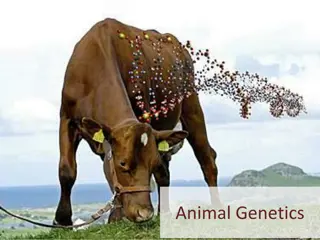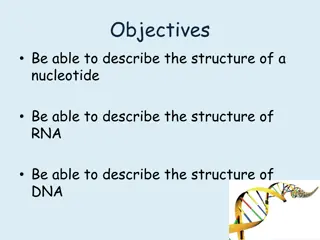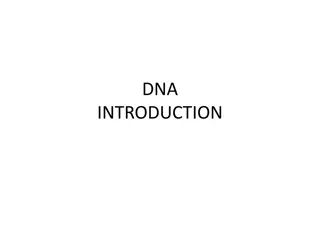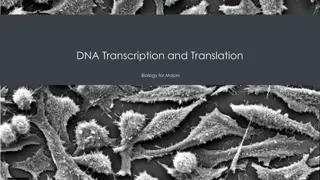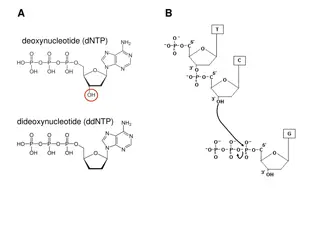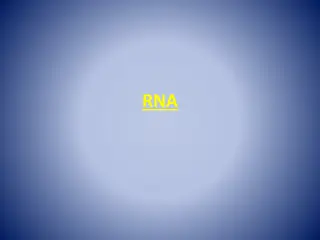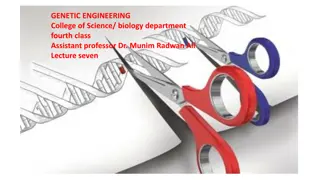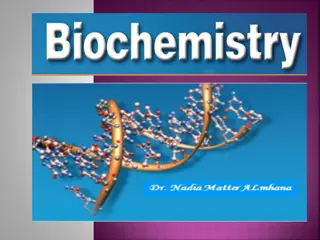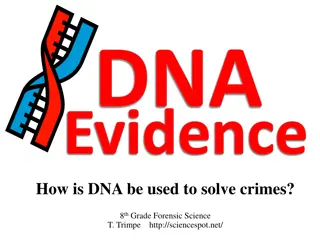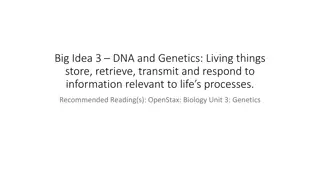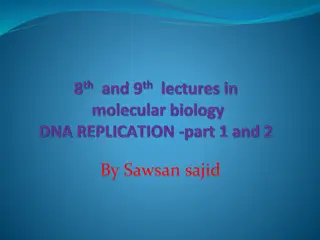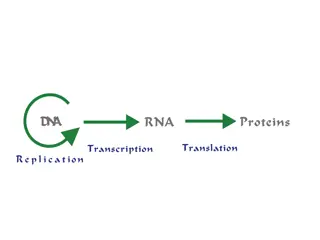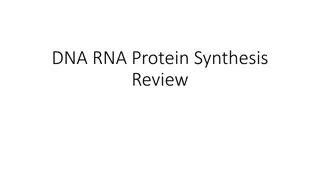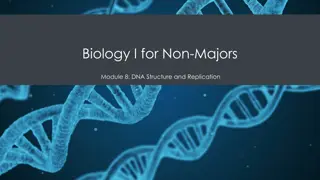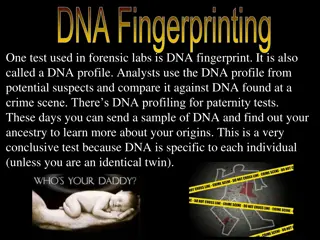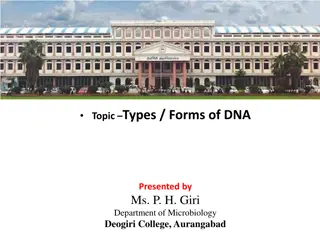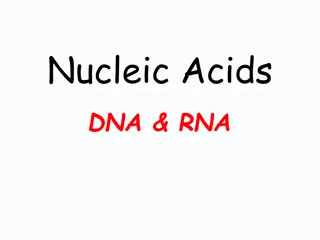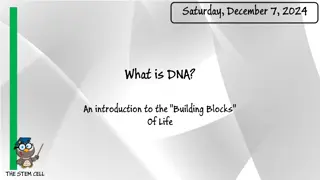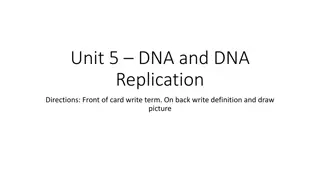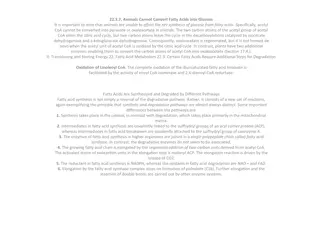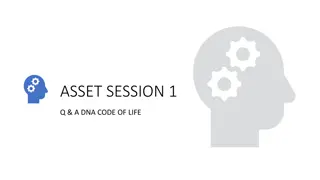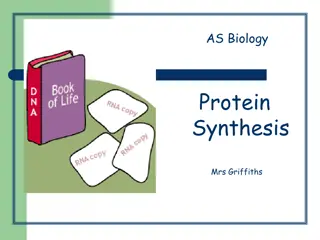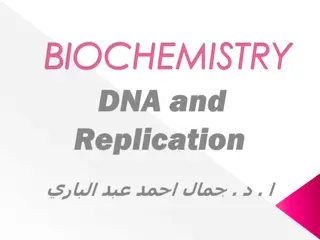Comprehensive DNA Characterization Methods in Molecular Biology
Explore the various techniques involved in the characterization of DNA, including spectrophotometric assay, melting temperature determination, quantitative and qualitative analyses, DNA purity assessment, GC content calculation, and DNA denaturation processes. Learn how to determine DNA concentratio
0 views • 12 slides
Understanding DNA Extraction from Strawberries in Molecular Genetics
In this molecular genetics lesson, students explore DNA extraction from strawberries. The content covers the structure of DNA, nucleotides, and the role of DNA in determining genetic information. Students learn about the components of nucleic acids, DNA functions, and the double helix structure of d
0 views • 87 slides
Understanding Animal Genetics: A Comprehensive Overview
Animal genetics is the study of heredity, inheritance of traits from parents to offspring, genetic material like DNA, chromosomes, genes, alleles, and nucleotides. It involves the understanding of chromosomes in different livestock species, DNA as the carrier of genetic information, genes as units o
0 views • 67 slides
Understanding the Structure and Importance of DNA
Explore the essential components and structure of DNA, including nucleotides, RNA, and the significance of DNA in carrying genetic information across generations. Learn about the four DNA nucleotides, how mononucleotides are formed, and the discovery of DNA's structure. Dive into base pairing and th
0 views • 30 slides
Understanding the Relationship Between DNA and Protein Specificity
The relationship between an organism's DNA and protein specificity is intricate. DNA encodes the information for the sequence of amino acids in proteins, thereby determining their specificity. This process involves DNA directing the synthesis of specific RNA molecules, which are then translated into
0 views • 17 slides
Understanding DNA Ligation Techniques for Molecular Biology Applications
DNA ligation involves joining DNA fragments to vectors to create new DNA or plasmids. Methods include DNA ligase, T4 ligase, and terminal deoxynucleotidyl transferase. Linkers and adaptors play a key role in DNA cloning experiments by generating sticky ends for DNA cloning. The use of adaptors allow
1 views • 13 slides
Understanding DNA Replication in Prokaryotes for B.Sc. Botany Hons. Students
Study material on DNA replication in prokaryotes focusing on key concepts like semiconservative mode of replication, involvement of enzymes, different models for understanding replication, and the bidirectional nature of DNA replication in prokaryotes. The material covers the process steps including
0 views • 33 slides
Pulsed-Field Gel Electrophoresis: Separating Large DNA Molecules
Pulsed-Field Gel Electrophoresis (PFGE) is a technique developed to effectively separate large DNA molecules through the application of an electric field that periodically changes direction. This method, introduced by David C. Schwartz and Charles C. Cantor in 1984, revolutionized the resolution of
1 views • 11 slides
Mechanism of Action of Antifolate Drugs in Bacterial Synthesis
Folate-derived cofactors are crucial for cell growth, with bacteria relying on de novo synthesis while humans need preformed folate. Antifolates like sulfonamides and trimethoprim disrupt folate synthesis in bacteria, inhibiting DNA synthesis. This article explores how these drugs target bacterial e
0 views • 34 slides
Understanding Epigenetics: DNA Methylation and Histone Modification
Epigenetics refers to changes in gene expression without altering the DNA sequence. This involves processes like DNA methylation, histone modification, and microRNAs. DNA methylation is controlled by DNA methyltransferase enzymes and plays crucial roles in gene activation and silencing. Histone modi
0 views • 13 slides
Understanding DNA Profiling: Techniques and Applications
DNA profiling, invented by Alec Jeffreys in 1985, is a technique used to distinguish between individuals of the same species based on their DNA. The process involves breaking down cells to release DNA, cutting the DNA into fragments using restriction enzymes, separating and analyzing fragments based
12 views • 23 slides
Understanding DNA: A Journey from Friedrich Miescher to Genes and Function
DNA, the hereditary basis of life, was first discovered by Friedrich Miescher in 1869. It consists of chromosomes, plasmids, and organellar DNA, collectively known as the genome. Genes, sequences of DNA, encode proteins and RNA, essential for an organism's functions. The genome is divided into chrom
0 views • 17 slides
Understanding DNA, Chromosomes, and Chromatin Structure
DNA is made up of genes, chromosomes, and chromatin. Genes carry vital information for protein synthesis, while chromosomes are condensed DNA required for cell division. Junk DNA are non-coding regions, and sister chromatids are identical DNA copies. Homologous chromosomes have matching structures,
1 views • 17 slides
Insights into Biological Synthesis Techniques and Related Work
Explore the biological synthesis project by Sumay and Sumit Gulwani at MSR Redmond. The project delves into template-based approaches and safety considerations in artifact synthesis. The outline covers inductive synthesis, challenges, and successes in achieving synthesis goals. Discover unique namin
0 views • 15 slides
Understanding Recombinant DNA and Gene Cloning
Recombinant DNA is artificially created by combining DNA from multiple sources into a single molecule. This process involves treating DNA with restriction endonucleases, such as BamHI, which cut at specific sites, resulting in sticky ends that can base pair with complementary DNA molecules. DNA liga
0 views • 33 slides
Understanding Transcription and Gene Expression in Biology
Explore the intricate process of transcription in biology, where mRNA is synthesized from DNA to carry the genetic code for protein production. Learn about the connection between genotype and phenotype, the role of genes in protein synthesis, and the significance of terms such as RNA Polymerase, int
0 views • 16 slides
Understanding DNA Transcription and Translation in Biology
DNA transcription is the process where DNA is used as a template to create mRNA in the nucleus. This mRNA is complementary to the DNA and goes through initiation, elongation, and termination stages. RNA polymerases are essential for this process in eukaryotes. Various RNA polymerases have specific f
0 views • 47 slides
Understanding Sanger DNA Sequencing Procedure
Overview of Sanger (dideoxy) DNA sequencing, involving deoxynucleotides and dye-labeled dideoxynucleotides to image DNA band sizes. The simulation model includes steps like denaturing DNA, annealing primers, and synthesizing DNA chains using dNTPs and ddNTPs. The process culminates in electrophoresi
0 views • 7 slides
Overview of Thermostable DNA Polymerases and Their Properties
Thermostable DNA polymerases play a crucial role in various molecular biology techniques, with Taq DNA polymerase being a household name due to its discovery in Thermus aquaticus. These enzymes catalyze DNA synthesis, require magnesium ions for activity, and exhibit optimal function at high temperat
0 views • 8 slides
Understanding RNA and Protein Synthesis Processes
RNA plays a crucial role in protein synthesis as it carries coded instructions from DNA. There are three types of RNA - mRNA, rRNA, and tRNA, each serving specific functions in the process. The steps of protein synthesis involve transcription, where DNA is copied into mRNA, and translation, where mR
0 views • 11 slides
Understanding DNA Transformation in Bacterial Cells
DNA transformation is a crucial process in genetic engineering, where foreign DNA is introduced into bacterial cells such as E. coli. This process, known as transformation, involves making the cells competent to uptake DNA through physical and chemical treatments. The uptake of DNA occurs after trea
0 views • 34 slides
Understanding DNA Structure: A Comprehensive Overview
DNA, or deoxyribonucleic acid, is a fundamental molecule in genetics. It consists of two antiparallel polynucleotide chains made up of monomer units containing sugars, phosphates, and nitrogenous bases. The structure of DNA includes deoxyribose sugar, phosphate groups, and nitrogenous bases like ade
0 views • 18 slides
Understanding DNA Structure and Genetic Information Encoding
Complementary nitrogenous bases in DNA, pyrimidines (thymine, cytosine) and purines (adenine, guanine), store biological information through antiparallel strands. DNA, with non-coding regions, undergoes replication and transcription to RNA for protein synthesis. Nucleic acids, DNA, and RNA are cruci
0 views • 7 slides
Understanding DNA Replication Process in Living Organisms
DNA replication is a fundamental biological process where an original DNA molecule produces two identical copies. This process involves initiation, elongation, and termination stages, utilizing replicator and initiator proteins. The DNA is unwound and replicated with the help of enzymes like helicas
0 views • 16 slides
Understanding DNA in Forensic Science: Solving Crimes with Evidence
DNA, or deoxyribonucleic acid, plays a crucial role in solving crimes by providing unique genetic information that can link suspects to evidence, identify victims, and link crime scenes. Factors such as environmental conditions can influence the reliability of DNA evidence. CODIS, the Combined DNA I
0 views • 8 slides
DNA Extraction from Blood: Methods and Protocol
Studying DNA is crucial for disease prevention, diagnosis, and treatment. This guide provides a step-by-step protocol for extracting DNA from blood, involving procedures like cell lysis, protein and RNA removal, DNA precipitation, and final nucleic acid determination. Key steps include using reagent
0 views • 6 slides
Understanding DNA and Genetics: A Comprehensive Overview
Living things store, retrieve, transmit, and respond to information essential for life processes. This encompasses the heritability of genetic traits through DNA and RNA, the discovery of the double helix structure of DNA, and key experiments validating DNA as the heritable molecule. Explore the com
0 views • 30 slides
Understanding DNA Replication: From Basics to Lab Synthesis
DNA replication is a fundamental process in all living organisms, essential for biological inheritance. This comprehensive guide explores the stages of DNA replication, highlighting key experiments and differences between prokaryotic and eukaryotic replication. Additionally, it delves into the revol
1 views • 31 slides
Understanding DNA, RNA, and Transcription Process
The content delves into the intricacies of DNA and RNA, highlighting the significance of DNA safety in the nucleus, the role of RNA in protein synthesis, different types of RNA, the transcription process, and the importance of RNA in genetic information transfer. It also discusses how DNA is transcr
0 views • 35 slides
Understanding DNA, RNA, and Protein Synthesis: A Comprehensive Review
Explore the fundamentals of DNA, RNA, and protein synthesis in this detailed review. Learn about the structure of DNA, the role of different nucleotides, DNA replication process, RNA structure, various types of RNA, transcription from DNA to RNA, and translation from RNA to protein. Dive into the wo
0 views • 16 slides
Understanding DNA Structure, Replication, and Proofreading
Exploring the intricate world of DNA, this module delves into the structure of DNA, highlighting nucleotides, nitrogenous bases, and the double helix. It emphasizes how DNA stores genetic information in genes and undergoes replication through a semi-conservative model. The process of DNA replication
0 views • 13 slides
Understanding DNA Fingerprinting and Its Applications
DNA fingerprinting, also known as DNA profiling, is a crucial technique used in forensic labs for identifying suspects or determining paternity. By cutting DNA with restriction enzymes and using gel electrophoresis, DNA fragments are separated according to size to create unique profiles. This highly
0 views • 20 slides
Understanding Different Forms of DNA Structures
DNA can exist in various forms such as single-stranded, double-stranded, and mixed forms. The primary, secondary, and tertiary/quaternary structures play crucial roles in determining the overall structure of DNA. Forms like A-DNA and B-DNA have distinct characteristics and are commonly found in diff
0 views • 57 slides
Understanding Nucleic Acids: DNA and RNA Overview
Nucleic acids, including DNA and RNA, are essential molecules storing genetic information for cellular functions. Comprised of nucleotides with nitrogenous bases, sugars, and phosphate groups, they play crucial roles in intracellular signaling, energy transfer, and genetic makeup determination. Ribo
0 views • 26 slides
Understanding DNA: The Building Blocks of Life
DNA, or Deoxyribonucleic Acid, is a fundamental chemical substance found in all cells of both plants and animals. It contains coded information necessary for organism development, using four base molecules - Uracil, Adenine, Thymine, Cytosine, and Guanine. These bases combine with phosphate and suga
0 views • 11 slides
Understanding DNA and DNA Replication: Key Concepts with Visual Aids
Explore essential terms related to DNA and DNA replication, including chromosomes, genes, nucleotides, double helix structure, hydrogen bonds, and more. Discover the process of DNA replication, involving enzymes like DNA polymerase and helicase, and the concept of semi-conservative replication. Rein
0 views • 13 slides
Understanding Fatty Acid Metabolism in Animals
Animals cannot convert fatty acids into glucose due to the inability to synthesize glucose from fatty acids. The process involves acetyl-CoA not being converted into pyruvate or oxaloacetate, leading to the citric acid cycle and differences between fatty acid synthesis and degradation pathways. Key
0 views • 8 slides
Understanding DNA: Basics, Analysis, and Protein Synthesis
Explore the world of DNA starting from the fundamentals of nucleotides and base pairs, to analyzing DNA samples for forensic purposes, and understanding protein synthesis stages. Engage with visual aids and questions to test and expand your knowledge about the code of life.
0 views • 5 slides
Protein Synthesis Process Explained with Mrs. Griffiths
The protein synthesis process involves transcription where mRNA is made from DNA, followed by translation where tRNA molecules bring amino acids to assemble a polypeptide chain. This detailed explanation by Mrs. Griffiths covers the steps of DNA unwinding, mRNA formation, tRNA activation, ribosome a
0 views • 26 slides
Insights into DNA Replication and Chromosome Structure
DNA replication is a fundamental process vital for the transmission of genetic information. Chromosomes, composed of DNA-protein complexes, store genetic information, and replication involves the synthesis of new DNA molecules. Enzymes play crucial roles in DNA synthesis, and in E. coli cells, repli
0 views • 16 slides


